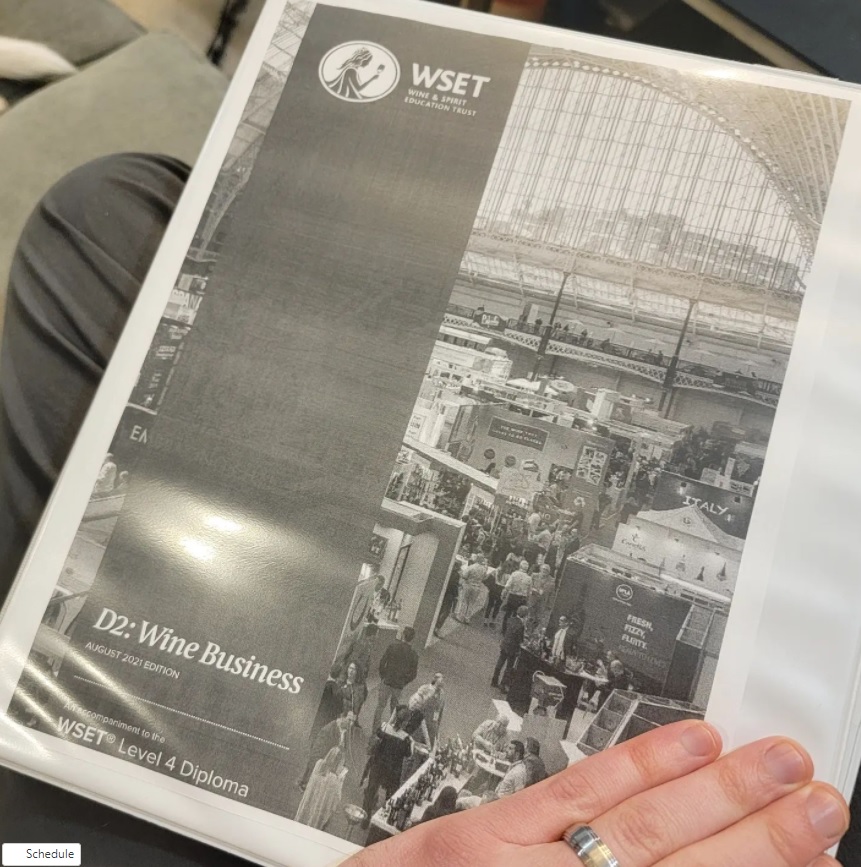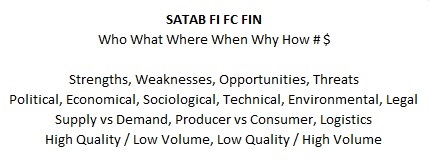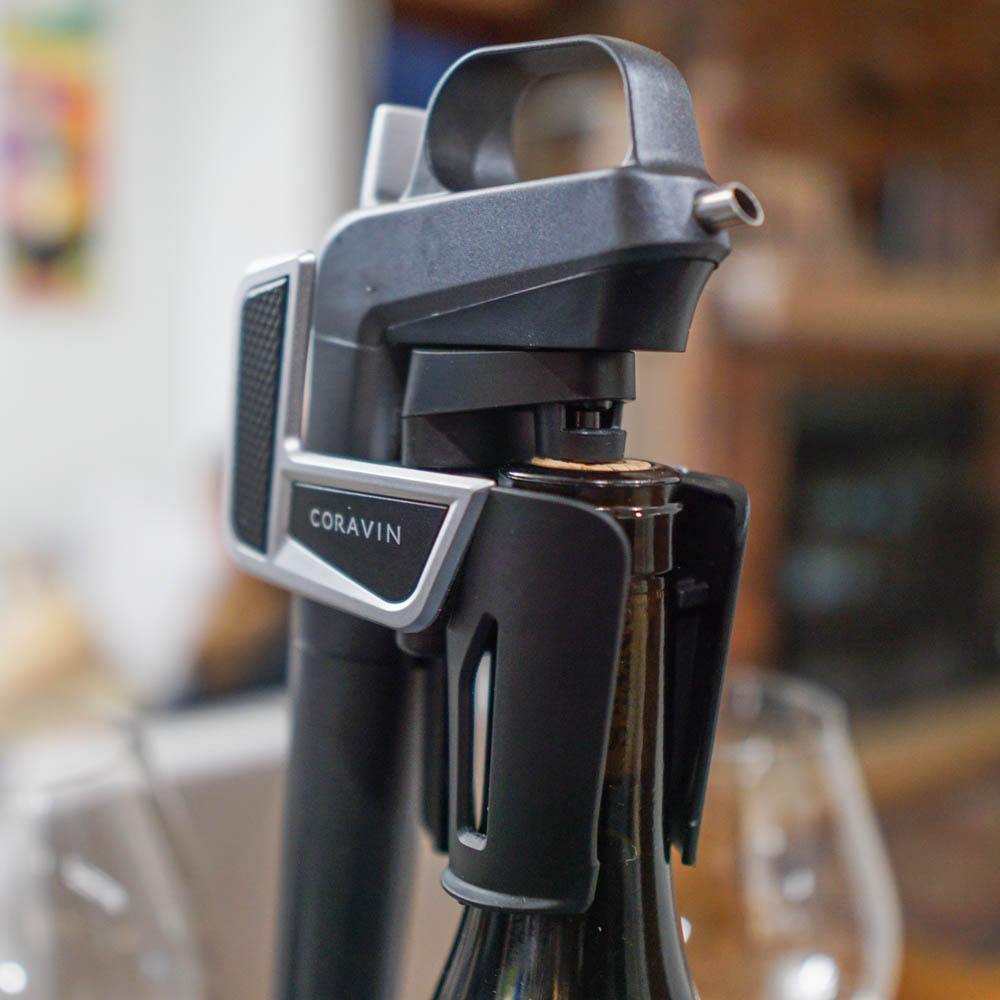Published by Jeremy.
Disclaimers: We use demographic data, email opt-ins, display advertising, and affiliate links to operate this site. Please review our Terms and Conditions for more information. This website is intended for those of legal drinking age in your jurisdiction.
When it comes to the WSET Diploma module D2, entitled Wine Business, you may look at this course in one of two ways.
The first thought is that it is a business course and can't be too bad. The second is that this one is completely new to WSET and could be a challenge simply because you haven't seen any of the material before.
As I used to work in sales and run my own business, I honestly felt like the course was going to be in the former category. As it turns out, it was most certainly the latter. WSET Diploma D2 is a rough one as the exam really can be all over the place!
In this one, I wanted to walk through what to expect with the WSET D2 exam and give some tips on how to prepare!
Note: I took the WSET Diploma D2 exam in March 2022. Test material and structure can and does change over time. I passed D2 with merit.
What to Expect in the WSET D2 Exam
If you are planning to take the WSET D2 exam, odds are good you have either already completed the WSET D1 exam or will be taking it shortly- the program requires you to take D1 and D2 before moving on to subsequent modules.
- If you have not sat for the D1 exam yet, please check out our WSET Diploma D1 exam tips post before reading this one. We may gloss over some points under the assumption you've already completed D1 and know a bit about what to expect.
Thankfully, as alluded to above, the WSET Diploma D2 exam follows the same general format as the D1 exam with the only major difference being the time allotted for the exam. That is to say, it is entirely essay-based with no tastings. It is just you, a pen or pencil, scratch paper, and just 60 minutes to write as much as you possibly can to hit that coveted 55% passing score.
As with all essay exams in the WSET program, the questions you can receive may run the spectrum from a quick, 5% question asking you to define a term in a sentence or two all the way to a 50% question where you have to evaluate a specific topic over the course of several pages. To translate the points another way, if you receive a question worth 5%, you're expected to spend 5% of your time answering it- or about 3 minutes in D2. If you receive a 50% question, you should spend 30 minutes on it, and so on.
Our instructor made it pretty clear that historically the exam tends to be four to five questions that are a bit larger in point value (20-50%), but this is never guaranteed. Where my D1 had four questions with roughly equal weighting, my D2 had the same number of questions but covered a larger range in weighting (thus it was expected I provided a more robust answer for one, and less on others). Independent of these minor differences, what you should expect is to have questions requiring a much more thorough analysis as is generally expected in the Diploma level.
The biggest issue that the D2 module has is you may have to evaluate specific scenarios related to the business of wine while using logic and reason to justify your statements (i.e. taking scenarios from the book and applying them in a new context). This tends to be one step further than that of D1 where you are often simply evaluating facts presented in the book alone (i.e. evaluating winemaking choices that are discussed at length in the source material).
In D2, you could be expected to take some leaps to apply what you've learned to the wine world at large.
For example, a broad question could be something along the lines of “Evaluate the options a low volume, high-quality Cabernet producer has to sell bottles during a recession.” This, of course, is a made-up question of my own making, but if you've read the book you should see how open-ended and ambiguous this question is. Recessions are talked about for maybe one paragraph in a very specific table. So to answer a 25% question on the topic requires a robust application of the material beyond what you read in the book.
In fact, while I never post the actual questions I had on my exams out of respect for the program, I can say that most of the questions I had to answer were rather ambiguous like the above and tripped up many, many students.
There is also an added layer of complexity with D2 in that all of the material you learned in D1 (and even Level 3) is considered fair game to a degree. For example, you may be asked a question about the costs that go into making a high-end wine. The book goes over winemaking choices in relation to price in some detail, but it also assumes you know the D1 material well enough to make some necessary leaps for yourself.
Could you pass the exam on the details provided in the D2 book alone? I'll give that a solid probably. If my exam was any indication, this should be quite doable. But could you pass with merit or distinction? I don't know about that.
As such, the exam question for D2 could expect you to take some leaps a bit more than you are used to in D1 and especially WSET Level 3. This exam really is a test in applying what you should know up to this point, and that is a challenge that cannot be understated.
Logic to Consider for the WSET D2 Essays
One of the biggest issues in WSET D2 is that the program only starts to approach how you should analyze things towards the end of the book (particularly in the marketing chapters although the logic can apply everywhere). The first half, sadly, feels a bit more matter-of-fact in terms of wine business topics whereas the exam is very likely to focus on evaluation-style scenarios where you must apply what you learned overall.
As such, the first thing you should be prepared for is to re-read the book- possibly multiple times over (I read it about six times). When doing so, you should think about the material in an analysis mindset via topics introduced towards the end of the book- the most important being the 5P's, SWOT, and PESTEL.
These are concepts that are quite useful for diving deep into any sort of question that requires a thorough evaluation. But as they are only introduced in the final chapters, you may not understand the significance until you go through a re-read (or two). Commit these 15 terms to memory as fast as possible and think about everything in relation to these terms moving forward.
The following is a quick breakdown of why these terms matter.
The 5 P's are Product, Price, People, Place, and Promotion. These are great cues to remember to apply context to any discussion. What does the product have to do with the question? How does a certain factor affect the price? What are the people components (both staff and customer)? What are the place components (running from anywhere in the field to point of sale and everything in between)? What marketing techniques go in for promotion? Odds are good a few of these could apply to any question asked in a D2 exam.
In an evaluation scenario, you may not be able to talk about all five points pending the nature of the question. But these are great cues to help you generate ideas to construct a complete answer outright.
From there, you may be able to extrapolate a bit, too. “Place”, per D2 reading, is typically referring to where wine is sold. But if you think of it with the lens of in the winery or vineyard topics too, you just gave yourself more context to consider for a question when topically relevant- and those may require thinking back to D1 or Level 3 for providing further depth as well.
The other major topic introduced at the end of the book is a SWOT analysis and the PESTEL acronym. Once again, these are discussed within the lens of marketing campaigns, but in the right context you really can apply the terms to just about anything in D2.
SWOT isolates Strengths (S), Weaknesses (W), Opportunities (O), and Threats (T) for any given business/marketing decision and PESTEL gives you a rubric of topics to consider within the framework- Political, Economical, Sociological, Technical, Environmental, and Legal. In some cases, external politics may present an opportunity, in others a threat. Internal technical capabilities could be a strength, or they could be a weakness.
Where things get fun is you can do a SWOT analysis on any of the categories of the 5 P's. So for any given product in a specific context, what are the SWOT and how do PESTEL components contribute? How about place? What about price? Extrapolating out these three core themes can cover up to 120 unique scenarios (5 Ps x 4 SWOT x 6 PESTEL) and that is a powerful starting point for a 20% question where you may only need to discuss a few scenarios to pass.
Will every combination apply to any given question? No, not even close. But you should be able to look at a question and these terms and, when relevant, instantly pull out the relevant topics you want as a starting framework for your answer.
- Note: While I say that there are 120 combinations for the 5 Ps, 4 SWOT, and 6 PESTEL combinations, I should highlight that some combinations don't actually make sense in practice. Politics, for example, is often an external factor so it may only have opportunities or threats as a producer has little control over the matter. Considering all combinations is simply a starting point to spark ideas when answering any question.
The test gets harder in that you may also need to keep in mind all of the other facts and scenarios discussed not only in D2 but D1 and even maybe Level 3 as well.
This could mean evaluating price or place in the context of the USA's three-tier system or a free market. Or maybe in a restaurant within the USA's system. This could mean discussing products or people in the realm of how wine is made or how grapes are grown outright (for example, in the context of biodynamic wine). You may be asked to evaluate a business decision within a certain region, too, and it could even be a region that wasn't mentioned in D2 at all. I could go on.
So while I considered some of those topics “matter-of-fact” early on, you can see how they can be woven into an analysis all the same.
As such, I should reiterate that for D2 the above discussion is only really a starting point to begin constructing your answers- not finish them outright. You'll then need to lean into all the other facts you learned to round out your response.
If you think this sounds like a lot, you're right. The reason I'm leaning hard into the logic on how to craft your answer is simply that so many students forget core topics outright once they read the questions. So going in with a solid understanding of the framework, especially for analysis style questions, goes a long, long way.
Thankfully, I've got a trick for this one that has served me well so far.
In all of my essay tests, I always take a minute or two at the start of the exam to write down all the keywords I don't want to forget in the heat of the moment. While WSET does not allow you to take any notes into the exam, you are allowed blank scratch paper to write out notes after the exam begins. So after the proctor says “begin” and before I read any question, I wrote out the following keywords on my paper for reference throughout the test:
These amount to the 5 P's, SWOT, PESTEL, a few core topics/scenarios found in D2, qualitative/quantitative terms, and some D1 and Level 3 terminology for good measure- all topics that could be referenced for any given question. (SATABFFF is my shorthand for the tasting grid- sweetness, acidity, etc. to flavor intensity, finish- a good reminder for discussing impacts on the final wine.)
Only after writing these down do I read the questions, and then I immediately review this list to pick out the core topics I want to write about. This means I only have to remember these keywords once (at the start of the exam), and having them in front of me ensures I don't space out and forget them later on. I still feel like I miss some thoughts, naturally, but this process helps keep that to a minimum.
If you had a question relating to a producer, for example, this table would remind you consider it in context of both producer types- high quality / low volume and low quality / high volume. If you just rattle off facts without this context, you may miss a good number of points because these two producer types could approach the topic differently. Likewise, if you only talk about product but the context of the question applies to price and place well, you probably just lost points there, too.
As such, I always find writing these key indicators out on my scratch paper to be exceptionally valuable at test time. But, once again, you can only write these out when the exam starts and not a moment sooner. Make your own list of terms you want to remember (or corresponding shorthand/acronyms if those work for you) and practice writing them out ahead of time as fast as you possibly can. This took me about two minutes at the start of the test, and I always consider it a good sacrifice of time.
Finally, remember that D2 is an absurdly short, 60-minute exam. To be quite honest, I felt like I could've used 20 more minutes on this one to hit everything I wanted to talk about whereas for the D1 exam I was done with 10 minutes to spare for review. I had no breathing room here whatsoever and only had a minute or two to go through and count the “points” I was trying to hit right before time ran out.
In the 58 minutes I was writing (minus two for writing out the above grid on my scratch paper), I ended up writing just under seven pages in total. Yes, seven. Yes, many students in my exam were shocked by this, and I hope it probably got me extra points simply by volume. In a way, my answers were not crafted to be perfect essays. Some probably read like a bit of word salad with some terrible grammar errors, and my handwriting is likely borderline on illegible, but all the WSET program cares about is you making your point. So make it fast.
If you can, use three words instead of seven. Cross out a misspelled word instead of erasing. Spend literally every second you can writing because the more you are thinking or making notes on scratch paper, the less you are getting out on the exam the evaluators actually read. That is truly the only thing that matters.
So if you are a slow writer, well, you certainly will want to practice speeding up here too, because the difference between writing seven pages and writing three pages could not just mean pass with distinction and a simple pass, but the difference between a pass and a fail outright.
This one really is harder than it looks.
Have you taken the WSET Diploma D2 exam? What would you have done differently to study for it? Comment below to share your thoughts!
Upgrade Your Home Wine Bar
Need to upgrade your wine bar? Grab some new wine accessories:






Great post Jeremy! I took D2 in March as well and will get to retake it again in October (the day before I take D3). I have an extensive business background and definitely took this test too lightly with a lot of overconfidence. Now that I am properly humbled, I will give this exam the focus it deserves. Your post is a wonderful guide on how to prepare for this exam. Thanks!
Oof, sorry to hear about having to re-take. But I think you’re going to go into the October exam well prepared. Although, to be fair, that exam was brutally ambiguous too!
I will take the D2 exam tomorrow – excited and a little anxious for it! Really love your tips 🙂 hope to get at least a “pass” tomorrow!